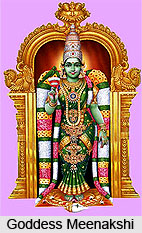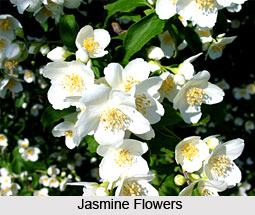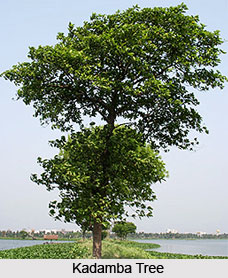 Madurai district is located in the southern part of the state of Tamil Nadu. It is bounded on the North by the districts of Dindigul, Thiruchirapalli and to the east by Sivagangai and to the west by Theni and to the south by Virudhunagar. The total area covered by this district is 3741.73 square kilometres. The district of Madurai is surrounded by several mountains. This district also has three hills as its boundaries as Yanaimalai, Nagamalai, Pasumalai named after Elephant, Snake and Cow respectively. The district is famous for Jasmine flowers. Jasmine flowers from the district of Madurai are transported to other cities of India. There are several temples in this district which attract people from different parts of the state and various other parts of India.
Madurai district is located in the southern part of the state of Tamil Nadu. It is bounded on the North by the districts of Dindigul, Thiruchirapalli and to the east by Sivagangai and to the west by Theni and to the south by Virudhunagar. The total area covered by this district is 3741.73 square kilometres. The district of Madurai is surrounded by several mountains. This district also has three hills as its boundaries as Yanaimalai, Nagamalai, Pasumalai named after Elephant, Snake and Cow respectively. The district is famous for Jasmine flowers. Jasmine flowers from the district of Madurai are transported to other cities of India. There are several temples in this district which attract people from different parts of the state and various other parts of India.
History of Madurai District
As per legend, the district of Madurai was originally a forest known as Kadambavanam. One day, a farmer named Dhananjaya while passing through the forest, saw Indra worshipping a swayambhu, a self-created Lingam, under kadamba tree. The farmer Dhananjaya immediately reported this to King Kulasekara Pandya. Then Kulasekara Pandya cleared the forest area and constructed a temple around the Lingam. Settlement was also planned with the temple as its centre. On the day of naming the place, Lord Shiva is said to have appeared and drops of nectar from his hair fell there. Thus, the place was named Madurai which means `sweetness` in Tamil language.
Geography of Madurai District
The Madurai district is having its border as the Dindigul district to the North, to the East is the Tiruchirapalli district, to the East by Sivagangai, to the West by Theni and to the South by Virudhunagar. Madurai is surrounded by several mountains. This district lies between nine degree thirty minutes and ten degree thirty minutes to the North latitudes and between seventy seven degree and seventy eight degree thirty minutes to the East latitudes.
Festivals of Madurai District
 One of the most prominent festivals in the district of Madurai is the Pongal or the Harvest festival. People celebrate this festival by way of paying tribute to the Sun, nature and cattle for helping them with a rich harvest. The three day long festival is celebrated with great pomp and splendour. Bogi is celebrated on the first day of Pongal. Homes are given a fresh lick of paint and old articles are removed. Jallikattu or the taming the Bull is another major sport in the state of Tamil Nadu which is a part of the Pongal celebrations.
One of the most prominent festivals in the district of Madurai is the Pongal or the Harvest festival. People celebrate this festival by way of paying tribute to the Sun, nature and cattle for helping them with a rich harvest. The three day long festival is celebrated with great pomp and splendour. Bogi is celebrated on the first day of Pongal. Homes are given a fresh lick of paint and old articles are removed. Jallikattu or the taming the Bull is another major sport in the state of Tamil Nadu which is a part of the Pongal celebrations.
Chithirai festival is also celebrated every year on the full moon day of the Tamil month Chithirai which is from April to May. As per legend, Lord Vishnu, as Alagar, rode on a golden horse to the district of Madurai to attend the celestial wedding of Goddess Meenakshi with Lord Sundareswarar or Lord Shiva. This famous festival is celebrated with much solemnity and serenity. The festival of the Cradle is another notable celebration of this district. During this festival, the deities of Goddess Meenakshi and Lord Sundareswarar are taken out in procession to a mirror chamber and for nine days the deities are on a swing, which rocks gently. Avanimoolam festival is celebrated during the month of September in which the coronation of Lord Sundareswarar takes place. A dance festival is organized by the department of tourism for fifteen days in which exponents of various dance forms from all over the country perform in this festival. Apart from these, there is another festival called the Navaratri, which is grandly celebrated in this district of Tamil Nadu. It is held in honour of Goddess Meenakshi in all her forms, which embody fury, compassion and wisdom. During this nine day festival, Goddess Meenakshi is offered nine varieties of rice meals and nine varieties of flowers.
Tourist Places in Madurai District
The Meenakshi Sundareswarar twin temple is the pivot around which the district of Madurai evolved. The temple grew with the contribution of each dynasty and victorious monarchs, into an enormous complex extending over an area of sixty five thousand square meters. This temple first came in to being about two thousand years ago and was substantially expanded during the regime of Thirumalai Nayak from A.D. 1623 to A.D.1655. Lord Siva in his incarnation as Sundareswarar and his fish-eyed spouse, Meenakshi, are enshrined in this twin temple. There are four massive gateways enclosing these two shrines. Another temple of importance in this district is the Thirupparankundram temple. This temple is situated eight kilometres to the south of Madurai Railway Junction. It is one of the six abodes of Lord Subramanya and its innermost shrine is cut out of a solid rock.
 Alagar Koil is another major temple situated at a distance of twenty one kilometers to the North-east of Madurai. It is a celebrated Vishnu Temple dedicated to Lord Alagar and situated on a hill amidst panoramic surroundings. The shrine is known as Alagarkoil and the hill is called Solaimalai. The temple also contains a number of beautiful carvings and makes the visit a rewarding experience. Palamudirsolai is one of the six abodes of Lord Subramaniya which is situated atop the Hill.
Alagar Koil is another major temple situated at a distance of twenty one kilometers to the North-east of Madurai. It is a celebrated Vishnu Temple dedicated to Lord Alagar and situated on a hill amidst panoramic surroundings. The shrine is known as Alagarkoil and the hill is called Solaimalai. The temple also contains a number of beautiful carvings and makes the visit a rewarding experience. Palamudirsolai is one of the six abodes of Lord Subramaniya which is situated atop the Hill.
Thirumalai Nayakkar Mahal is about fifteen hundred meters from the Meenakshi temple. The palace was erected in the year 1636 by the ruler whose name it bears. The imposing edifice is renowned for the `Stuccowork` on its domes and impressive arches. The Sorgavilasam or celestial pavilion, constructed entirely of brick and mortar without the support of a single rafter or girder, is a marvel of Indo-Saracenic architecture in India. Other striking features of the palace include massive white pillars, several of which line the corridor that runs along the courtyard.
Gandhi Museum is an outstanding place to be visited in the district of Madurai. Housed in the old Palace of Rani Mangammal, this museum depicts the highlights of the freedom struggle and contains a picture gallery of the Gandhian movement. There can also be seen a gallery of relics, Khadi and village industries section and South Indian Handicrafts section. Another attraction of the Madurai district is the Mariamman Teppakulam. It is a beautiful square tank which spreads over a huge area of almost sixteen acres, situated about five kilometres to the east of Meenakshi temple. This tank is the scene of the colourful float festival is held during January-February to celebrate the birth anniversary of King Thirumalai Nayak, who constructed this tank. The deities of Sundareswarar and Meenakshi are placed in a float known as `Teppam`, decorated with flowers and illuminated with hundred of lights. The float is taken around the tank to the sound of traditional music. There is a temple on the northern side of this tank which is dedicated to Mariamman, a famous village deity of Tamil Nadu. Thus, the district of Madurai in the Tamil Nadu state is a place filled with a number of temples as well as several other places of interest.






